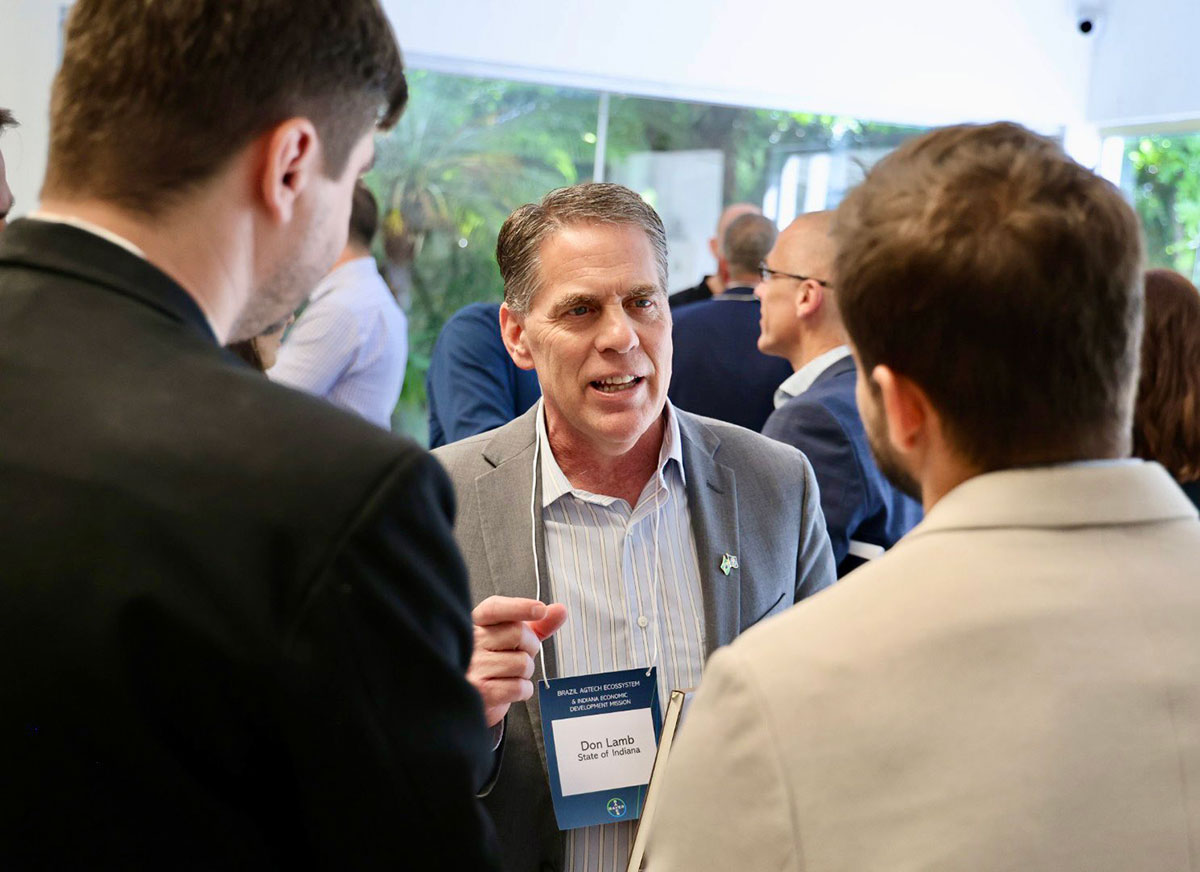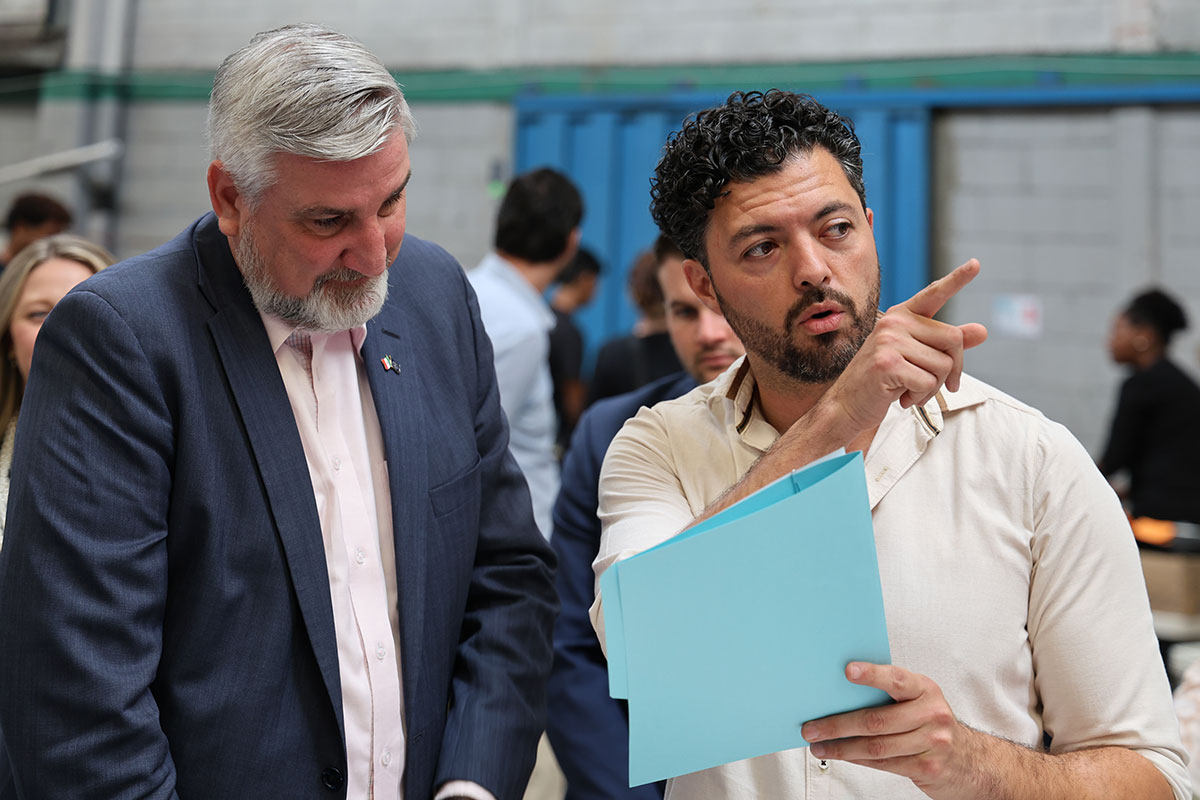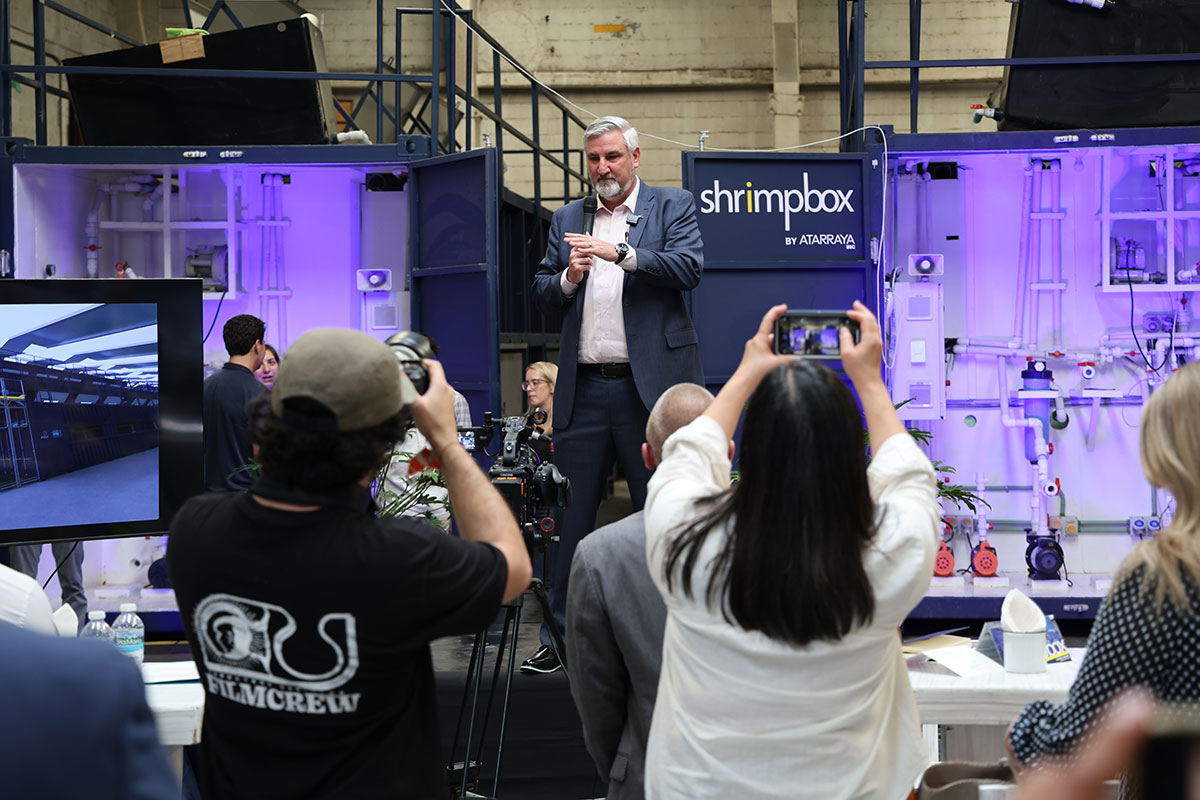Subscriber Benefit
As a subscriber you can listen to articles at work, in the car, or while you work out. Subscribe NowGov. Eric Holcomb led a trade trip focused on agriculture to Brazil and Mexico last month with the goal of strengthening ties with existing companies and finding new opportunities.
It was a relatively unusual trip, said Indiana State Department of Agriculture Director Don Lamb, who was on the Brazil leg of the trip. Typically, agriculture trade missions are led by the U.S. Department of Agriculture with state officials invited along for relevant destinations.
State trade trips are more often focused on manufacturing and technology.
But Mexico and Brazil are big trading partners for Indiana (and in some cases, competitors). And a number of key Indiana companies do business in those countries. So among those on the trip last month were representatives of AgriNovus Indiana, the Indiana Corn Marketing Council and Indiana Soybean Alliance, Purdue University, Weaver Popcorn, DPH Biologicals and other business leaders.
IBJ talked with Lamb, a second-generation Boone County farmer who has been in the ag post for one year, about the trip to Brazil, the importance of agriculture trade missions and Indiana’s import/export relationships.

What is an agricultural trade trip? What is your goal in going on a trip like this?
We export a lot of things out of Indiana. We’re the seventh-largest exporting state in the nation.
Many trips we go on are sponsored by the USDA—by the United States Department of Agriculture—and kind of coordinated in that sense for states like Indiana to be able to highlight their products. We’re always selling corn and soybeans and poultry and pork and beef and the things that we’re really good at. So that’s normally what it looks like.
How would you characterize the agricultural connection that Indiana has to both Brazil and Mexico?
Both Corteva [Agriscience] and Elanco have a pretty big presence in Brazil, so that’s important to us. Having such big ag bioscience companies located right here in Indianapolis, they are such a strength for us as a state because they really are world leaders in what they do. So connecting with their organizations in Brazil and seeing if we can support them any way we can was a big focus.
We also met with [Eli Lilly and Co.], which you don’t think of that necessarily on the ag side, but there’s really getting to be this “one health” type of a thinking when it comes to ag biosciences. And so Lilly plays a role in that human health is not so disconnected from animal health or disconnected from plant production.
Were there any specific deals that you were trying to close or any specific opportunities that you were trying to advance while you were there?
Yeah. I actually can’t report. There were some things that we were trying to do. They’re all under non-disclosure agreements, so I can’t give specifics.
I know with these types of trips, the governor will go to a place with a delegation, and then in the weeks to follow, you see this cascade of announcements. I wonder if we should be expecting any announcements from some of these deals that you just can’t talk about right now.
There definitely could be. I can’t guarantee anything, or I wouldn’t say to expect any sort of cascade of announcements. We’re hopeful. You always make connections, and you hope things go well.

What were the one or two big takeaways that you came home with?
In agriculture, many times we think of Brazil especially as competition. They’re big, they’ve got lots and lots of land, and when we compete with countries to export, they’re our biggest competition. They’re actually biggest in corn and soybeans now, bigger than the United States. That kind of hurts our pride in some ways.
So you might as well look for the areas where you can work together and where you can both benefit from your strengths. And Indiana has great strength in being able to provide products from commodities, so not just the base commodity but then to do something with that commodity and sell that to your customers. And we’ve got a real strength in that.
We have to concentrate on what we’re good at and let them concentrate on what they’re good at, and then where we can work together where we can be mutually beneficial.
If you say that Indiana’s strength is taking those commodities and making a refined product out of it, what would you say is Brazil’s strength?
Well, everything about Brazil is big. The city we were in, Sao Paulo, is a 20-million-person city, and the state of Sao Paulo’s got 40-some million people. … And then really expansive farmland and big areas of growing production. So their strength lies in growing big quantities of those products.
And so they’re going to be big producers of lots of crop, but it might not be a specific crop. In the United States, and Indiana really in particular, we’re good at raising a certain crop for a certain use and taking it to a certain market on time and with high quality.
Can you give me an example of some sort of specialty variety of crop?
Corteva has a soybean that is called a plenish soybean, and it’s a healthier oil to use, but it’s a specific soybean that’s grown for that purpose.
We can take that seed from the time we plant it until the time we harvest it until the time we process it and keep it in a chain. We can follow the chain of how that plant was produced to produce that specific healthy oil. So … a customer has confidence that you’ve delivered what you say you are going to deliver. It takes a lot of coordination, and Indiana is really good at doing things like that.
So one of the takeaways was … the importance of working together with somebody who is a competitor.
Yes. Just because the country competes with us doesn’t mean that there’s not advantages of being able to work together. We actually did a little bit of a—I’d almost call it a “Shark Tank”-type program—where some of [Brazil’s] startup companies that were tech companies in agriculture were able to say, “Here’s what we would like to do in the ag industry, and here’s what we’re producing.” And we were able to give them feedback.
And those companies might someday bring a product to us that either we could maybe manufacture here in Indiana, or it could be used here in Indiana. And it could be something that would benefit us in the future, but it also benefits them because it gives them a market.
The United States is still such a strong market for so many people—Brazil included. They want to be here; they want to be working here; they want to be selling their products here. And if we can use those products, well, it’s a benefit to both of us.
Did anything else stick out to you from this trip?
The relationships—not just with Brazil but for agriculture to be a teammate with the Indiana Economic Development Corp. and to have the two agencies working together. That’s a real strength.
The IEDC does such a good job of … promoting economic development. So to have that combination of agriculture and strong economic development was really good. And then you put on top of that the fact that the governor was there—and he does a very good job of representing Indiana.
So both the relationship with the Brazilian people that we were able to meet with and the relationship with the agencies that we get to work with here in Indiana, it was a really good trip for building up that team.
How common are these ag-focused trade trips for the state?
Our agency, the State Department of Agriculture, will be involved in 11 trips this year. … Most of those are in connection with the USDA and the foreign ag service. Most of those don’t really cost Indiana much in the way of resources.
We get to go along with a USDA trip and promote our products. So those are really efficient.
When you take an Indiana ag-specific trip like this one, it was well-organized, and I think it did us a lot of pinpoint work for Indiana specifically. But that takes a lot of work from people here in the state.
So we’ve learned to take advantage of the USDA trips because we get a lot of bang for our buck—and then take advantage of a trip like this. Maybe not very often, but when you do it, you do a really good job, and then you pinpoint it and you get the most bang for your buck that way because it’s specific to the state.
On the federal trips, who chooses the destination? Does the USDA say, “Hey, we’re going to this country,” and do you put in a request to go?
They give you kind of a list [of places the agency is going], and then they also know what states might be best represented in certain countries. We went to Indonesia, for example. And there was a time not too long ago, I didn’t think about Indonesia being a really big trading partner, but they’re the third most populous country in the world now, and they’re a huge potential market for soybeans.
So you have 11 trips this year. Where else have you gone this year, and where do you have yet to go?
Yeah. I’m not sure I can get them all off the top of my head. But I can tell you … I went to South Korea, went to Cuba. We’ve had people in India, in Indonesia, and we’re going to Vietnam. We were in Dubai. That was with our hardwoods, selling hardwoods in Dubai.
It seems like there’s a little bit of a subspecialty in Asia.
Yes. I went to Japan as well after I started this job. It was actually in the last calendar year. But you think about Japan and South Korea … they both don’t really have the ability or the capacity land-wise to raise enough food for themselves. They really need us.
But they’re also so important to that region because they’re right up against North Korea and China. The partnership with those two countries when you go there is so good because we’re really part of a team in so many different ways. They’re great trade partners; they’ve got a lot of technology that we use and then we have a lot of food for them. And then together, we’re able to be strong when we might have people that you might consider your adversaries not too far away.

What do you do other than business meetings on these trips?
This one especially was very busy with meetings, and … besides just meals that we were able to enjoy at the end of the day, we did not have any tours and we did not have any special things, celebrations to go to or anything.
And in a way, I really like it that way. This one was a fast one. That trip to Brazil, we were really only there 2-1/2 days. And so you just make the most of it and pack as much as you can into those 2-1/2 days.
What was your favorite thing that you learned or saw?
It’s always people, the people that you get to meet from that country. And in particular this time, I would say having the connection with our Indiana companies that are there. The leaders of Corteva, the leaders of Elanco, the leaders of Lilly—to be able to just spend some time with them. And it’s a little bit of home for them, and it’s also a connection for us and to kind of build up that team.
What are one or two exports from Mexico and Brazil that are commonly consumed by people here?
From Mexico, it would have to be fruits and vegetables. There’s certain times of the year that we just can’t grow some of the things that we want to eat. Even in California, we have seasons that change. So for Mexico, it’d be the fruits and vegetables.
And Brazil, they produce a lot of really big commodity crops, but they’re selling to the same people that we’re selling to.
One interesting thing I would say about Brazil that we have is the racing connection. Maybe it’s not agriculture, but here in Indiana, we’re really big with the Indy 500, and Tony Kanaan is Brazilian, and … there’s two or three Brazilian drivers. The racing connection with Brazil is probably a unique relationship that we have.•
Please enable JavaScript to view this content.


Can’t see Braun doing anything like this. He is a simply power-hungry do-nothing. How did he help IN as a US Senator? Did NOTHING. Will be a long 4 years with him. IN had been on quite a trajectory. That will end with Braun. Laziest power-grabber in IN history. Oh, but Trump loves him. 😡🤢 Stupid Hoosiers (redundant, I know) deserve what they get.